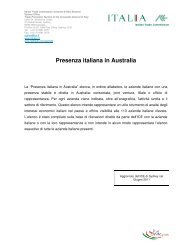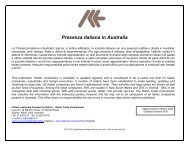Price Determination in the Australian Food Industry A Report
Price Determination in the Australian Food Industry A Report
Price Determination in the Australian Food Industry A Report
You also want an ePaper? Increase the reach of your titles
YUMPU automatically turns print PDFs into web optimized ePapers that Google loves.
5.3 The greater <strong>in</strong>fluence of prevail<strong>in</strong>g world commodity prices – <strong>in</strong> <strong>the</strong> primary product or <strong>in</strong><br />
early stages of process<strong>in</strong>g, this <strong>in</strong>fluences <strong>the</strong> threat of imports, as well as <strong>the</strong> benchmark<br />
prices that producers seek <strong>in</strong> <strong>the</strong> domestic market for commodities.<br />
Technology and <strong>in</strong>novation<br />
6.1 The <strong>in</strong>creas<strong>in</strong>g capital <strong>in</strong>tensity <strong>in</strong> product transformation and manufacture – which is<br />
chang<strong>in</strong>g cost structures to reduce a dependence on variable, globally uncompetitive labour<br />
costs towards greater associated fixed process<strong>in</strong>g costs, requir<strong>in</strong>g <strong>in</strong> turn greater consistency<br />
of production runs and limited downtime and product switch<strong>in</strong>g.<br />
6.2 The differ<strong>in</strong>g degrees of transparency <strong>in</strong> market conditions as to prices and costs – whilst<br />
also a factor that relates to <strong>the</strong> <strong>in</strong>tegration <strong>in</strong> <strong>the</strong> value cha<strong>in</strong>, <strong>the</strong> way <strong>in</strong> which knowledge is<br />
managed and shared through a value cha<strong>in</strong> to create certa<strong>in</strong>ty of <strong>the</strong> commercial environment<br />
is strongly <strong>in</strong>fluenc<strong>in</strong>g outcomes between sectors.<br />
6.3 Greater <strong>in</strong>vestment <strong>in</strong> <strong>in</strong>novation to diversify core products and extract value from<br />
co-products – as with 3.1, <strong>the</strong>re is pressure to depart from a heavy reliance on commodity<br />
products but also to ensure that <strong>the</strong> greatest potential value is extracted from <strong>the</strong> raw product<br />
through by-product or co-product processes.<br />
Consumer and retail market dynamics<br />
7.1 The growth of <strong>the</strong> private label <strong>in</strong> food products – retailers <strong>in</strong> <strong>the</strong> <strong>Australian</strong> domestic market<br />
have generally placed private label products <strong>in</strong>to discount categories which are reflected <strong>in</strong><br />
generally lower buy<strong>in</strong>g prices from suppliers. The growth of <strong>the</strong> private label has been fuelled<br />
by strong price competition to provide <strong>the</strong> retailer with greater control of <strong>the</strong> category and<br />
better marg<strong>in</strong>s from <strong>the</strong> use of shelf space.<br />
<strong>Price</strong> <strong>Determ<strong>in</strong>ation</strong> <strong>in</strong> <strong>the</strong> <strong>Australian</strong> <strong>Food</strong> <strong>Industry</strong> A <strong>Report</strong><br />
7.2 Greater demand for convenience and lifestyle solutions <strong>in</strong> meals and snacks – this is driv<strong>in</strong>g<br />
retailers and <strong>the</strong>ir suppliers to create more <strong>in</strong>novative options <strong>in</strong> convenience product form.<br />
There is less cook<strong>in</strong>g be<strong>in</strong>g done <strong>in</strong> <strong>the</strong> home and less cook<strong>in</strong>g from base <strong>in</strong>gredients. The<br />
concept of <strong>the</strong> meal is be<strong>in</strong>g redef<strong>in</strong>ed due to <strong>the</strong> nature of <strong>the</strong> busy city lifestyle. Changes <strong>in</strong><br />
<strong>the</strong> way that people are eat<strong>in</strong>g meals is challeng<strong>in</strong>g <strong>the</strong> role of conventional foods and<br />
product forms.<br />
7.3 Greater concentration <strong>in</strong> <strong>the</strong> retail sector – this is provid<strong>in</strong>g <strong>the</strong> cha<strong>in</strong> retailer with far greater<br />
barga<strong>in</strong><strong>in</strong>g power <strong>in</strong> negotiations with suppliers who are faced with decreas<strong>in</strong>g options <strong>in</strong><br />
many categories due to <strong>the</strong> size of retail market share that <strong>the</strong> cha<strong>in</strong> store offers. With greater<br />
barga<strong>in</strong><strong>in</strong>g power has come <strong>in</strong>creas<strong>in</strong>g imposition of <strong>the</strong> costs of retail (reflected <strong>in</strong> terms of<br />
trade) and marg<strong>in</strong> pressure on suppliers who are compet<strong>in</strong>g for available shelf space.<br />
18







